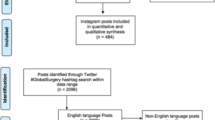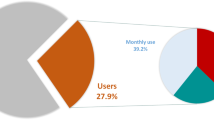Abstract
Purpose of review
This review summarizes the current applications of social media in regional anesthesiology, describes ways that specific platforms may promote growth, and briefly discusses limitations and future directions.
Recent findings
Although Facebook users outnumber Twitter users, the latter has been better studied in regional anesthesiology and may have the advantages of speed and expansion of reach. Highly tweeted publications are more likely to be cited in the medical literature, and twitter-enhanced journal clubs facilitate communication regarding important articles with international colleagues. In both the USA and internationally, Twitter has been shown to enhance the anesthesiology conference experience, changing communication amongst attendees and non-attendees. YouTube and podcasts are quickly finding a niche in regional anesthesiology for just-in-time training and continuing professional development.
Summary
Social media use is rapidly growing in regional anesthesiology, and benefits include global interaction and knowledge translation within the specialty and with the general public.

Similar content being viewed by others
References
Papers of particular interest, published recently, have been highlighted as: • Of importance •• Of major importance
Oxford Dictionraries. 2016. https://en.oxforddictionaries.com/definition/social_media. Accessed February 3, 2017
Buckarma EH, Thiels CA, Gas BL, Cabrera D, Bingender-Casey J, Farley DR. Influence of social media on the dissemination of a traditional surgical research article. J Surg Educ. 2017;74:79–83.
Wexner SD, Petrucci AM, Brady RR, Ennis-O’Connor M, Fitzgerald E, Mayol J. Social media in colorectal surgery. Color Dis. 2016; doi:10.1111/codi.13572.
Mariano ER, Marshall ZJ, Urman RD, Kaye AD. Ultrasound and its evolution in perioperative regional anesthesia and analgesia. Best Pract Res Clin Anaesthesiol. 2014;28:29–39. doi:10.1016/j.bpa.2013.11.001.
•• Ekins S, Perlstein EO. Ten simple rules of live tweeting at scientific conferences. PLoS Comput Biol. 10:e1003789. This article provides a concise introduction to Twitter for the new user as well as a thorough description of “live tweeting” from a scientific conference.
Cambridge Dictionary. Mewaning of “like” in the English Dictionary. 2017. http://dictionary.cambridge.org/dictionary/english/like#british-1-5-1. Accessed February 3, 2017
Utengen A. New healthcare analytics features for social media. Symplur Healthcare Hashtags Project website. Available at: http://www.symplur.com/shorts/new-healthcareanalytics-features-social-media/. 2012. Accessed February 3, 2017
De Groote SL, Dorsch JL. Measuring use patterns of online journals and databases. J Med Libr Assoc. 2003;91:231–40.
•• Eysenbach G. Can Twweets predict citations? Metrics of social impact based on twitter and correlation with traditional metrics of scientific impact. J Med Internet Res. 2011;13:e123. doi:10.2196/jmir.2012. This article coins the term “tweetations” and shows the effect that tweetations have on eventual number of traditional citations for research article. Citations lag years behind social media references. Highly tweeted articles are 11 times more likely to be cited.
• Peoples BK, Midway SR, Sackett D, Lynch A, Cooney PB. Twitter predicts citation rates of ecological research. PLoS One. 2016;11:e0166570. doi:10.1371/journal.pone.0166570. This is another article demonstrating the association between reference to an article on Twitter after publication and the likelihood of citation by future publications.
Duffy CC, Bass GA, Linton KN, Honan DM. Social media and anaesthesia journals. Br J Anaesth. 2015;115:940–1.
•• Udani AD, Moyse D, Peery CA, Taekman JM. Twitter-augmented journal club: educational engagement and experience so far. rA A Case Rep 2016; 253–256. This article presents the successful integration of traditional journal club, a learning experience for residents at an academic anesthesiology department, with Twitter to combine live in-person and virtual social media interactions.
Blanco R, Fajardo M, Parras MT. Ultrasound description of Pecs II (modified Pecs I): a novel approach to breast surgery. Rev Esp Anestesiol Reanim. 2012;59:470–5.
Li JW, Songthamwat B, Samy W, Sala-Blanch X, Karmakar MK. Ultrasound-guided costoclavicular brachial plexus block: sonoanatomy, technique, and block dynamics. Reg Anesth Pain Med. 2017;42:233–40.
History of YouTube [Internet]. 2007 [cited 20 February 2017]. Available from: https://en.wikipedia.org/wiki/History_of_YouTube
• McKendrick DRA, Cumming GP, Lee AJ. Increased use of twitter at a medical conference: a report and a review of the educational opportunities. J Med Internet Res. 2012;14:e176. doi:10.2196/jmir.2144. This is a good introduction to Twitter use during an anesthesia-themed medical conference.
•• Schwenk ES, Jaremko KM, Gupta RK, Udani AD, McCartney CJL, Snively A, Mariano ER. Upgrading a social media strategy to increase twitter engagement during the spring annual meeting of the american society of regional anesthesia and pain medicine. Reg Anesth Pain Med. 2017 Mar 6. doi: 10.1097/AAP.0000000000000586. [Epub ahead of print] PMID: 28267069. This is the first article to describe a specific social media strategy to increase Twitter engagement for a medical conference focused on regional anesthesiology and acute pain medicine. Twitter analytics are presented for two consecutive annual meetings, before and after the launch of a social media team.
Stiegler M. 5 Key reasons doctors should use social media. Available at: http://www.marjoriestieglermd.com/5-key-reasons-doctors-should-use-social-media/ 2014. Accessed February 24, 2017
Sun L. Twitter’s very real fake problem. Available at: https://www.fool.com/investing/general/2014/04/15/twitters-very-real-fake-problem.aspx 2014. Accessed February 28, 2017
Staff Writers. 99 Ways You Should Be Using Facebook in Your Classroom [Updated]. Available at: http://www.onlinecollege.org/2012/05/21/100-ways-you-should-be-using-facebook-in-your-classroom-updated/ 2012. Accessed March 3, 2017
Molla R. Social studies: Twitter vs. Facebook. Available at: https://www.bloomberg.com/gadfly/articles/2016-02-12/social-studies-comparing-twitter-with-facebook-in-charts 2016. Accessed February 25, 2017
Ranschaert ER, Van Oijen PMA, McGinty GB, Parizel PM. Radiologists’ usage of social media: results of the RANSOM survey. J Digit Imaging. 2016;29:443–9.
• Rossler B, Lahner D, Schebesta K, Chiari A, Plochi W. Medical information on the internet: quality assessment of lumbar puncture and Neuroaxial block techniques on YouTube. Clin Neurol Neurosurg. 2012;114:655–8. This article reviews the quality of video educational material available on YouTube.
Madathil KC, Rivera-Rodriguez AJ, Greenstein JS, Gramopadhye AK. Healthcare information on YouTube: a systematic review. Health Informatics J. 2015;21:173–94.
Smith A. Record shares of Americans now own smartphones, have home broadband. Available at: http://www.pewresearch.org/fact-tank/2017/01/12/evolution-of-technology/ 2017. Accessed: March 3, 2017
• Rothman BS, Gupta RK, McEvoy MD. Mobile technology in the perioperative arena: rapid evolution and future disruption. Anesth Analg. 2017;124:807–18. This article reviews mobile technology in healthcare from early experiences to the explosion of “apps” on smartphones.
Pierce R, Fox J. Vodcasts and active-learning exercises in a “flipped classroom” model of a renal pharmacotherapy module. Am J Pharm Educ. 2012;76:196.
Singh D, Alam F, Matava C. A critical analysis of anesthesiology podcasts: identifying determinants of success. JMIR Med Educ. 2016;2:e14.
Louis T. Twitter’s growing spam problem. Available at: https://www.forbes.com/sites/tristanlouis/2013/04/07/twitters-growing-spam-problem/#271edd01f4c3 2013. Accessed March 1, 2017
Thelwall M, Haustein S, Lariviere V, Sugimoto CR. Do Altmetrics work? Twitter and ten other social web services. PLoS One. 2013;28:e64841. doi:10.1371/journal.pone.0064841.
Author information
Authors and Affiliations
Corresponding author
Ethics declarations
Conflict of Interest
Eric S. Schwenk declares that he has no conflict of interest. Larry F. Chu declares that he has no conflict of interest. Rajnish K. Gupta declares that he has no conflict of interest.
Edward R. Mariano has received unrestricted funding for educational programs paid to his institution from Halyard Health (Alpharetta, GA) and B. Braun (Bethlehem, PA). These companies had absolutely no input into any aspect of manuscript preparation.
Human and Animal Rights and Informed Consent
This article does not contain any studies with human or animal subjects performed by any of the authors.
Additional information
This article is part of the Topical Collection on Regional Anesthesia
Rights and permissions
About this article
Cite this article
Schwenk, E.S., Chu, L.F., Gupta, R.K. et al. How Social Media Is Changing the Practice of Regional Anesthesiology. Curr Anesthesiol Rep 7, 238–245 (2017). https://doi.org/10.1007/s40140-017-0213-x
Published:
Issue Date:
DOI: https://doi.org/10.1007/s40140-017-0213-x




